Fracture Properties of Polystyrene Aggregate Concrete after Exposure to High Temperatures
Abstract
:1. Introduction
2. Theoretical Background
3. Materials and Methods
3.1. Materials
3.2. Heating Profile
3.3. Specimen Preparation and Testing
4. Results and Discussion
4.1. Mechanical Properties
4.2. Fracture Properties
4.2.1. Critical Effective Crack Length Ratio ()
4.2.2. Critical Stress Intensity Factor ()
4.2.3. Critical Crack Tip Opening Displacement ()
4.2.4. Critical Strain Energy Release Rate ()
4.2.5. Material Brittleness
4.2.6. Fracture Energy ()
5. Conclusions
- Compressive strength, tensile strength and elastic modulus of both PAC samples and the control concrete also reduced under the effect of increasing temperature. However, mechanical properties of PAC samples showed marginally more temperature sensitivity than control concrete.
- The critical stress intensity factor, the fracture energy and the critical strain energy release rate decreased by increasing the polystyrene aggregate content. It means that less energy is required for crack initiation and crack propagation in PAC samples compared to control concrete. This could be explained by lower aggregate-cement paste bond in PAC in comparison to control concrete.
- It was observed that PAC samples have higher values of characteristic length. This means replacing more normal aggregate with polystyrene aggregate caused the material failure mode to be more ductile.
- Increasing temperature affects the fracture properties of all three concretes similarly. Elevating the temperature from 25 °C to 500 °C reduced the amount of , and , leading to less cracking resistance in all specimen. In contrast, changing the temperature from 500 °C to 800 °C caused an increase in the required cracking energy.
Acknowledgments
Author Contributions
Conflicts of Interest
References
- Orsos, T. BST: The Lightweight concrete aggregate. In Proceedings of the Concrete Institute of Australia Seminar on Special Use Concretes, Melbourne, Australia; 1992. [Google Scholar]
- Ferrándiz-Mas, V.; García-Alcocel, E. Durability of expanded polystyrene mortars. Constr. Build. Mater. 2013, 46, 175–182. [Google Scholar] [CrossRef]
- Chen, B.; Liu, J.; Chen, L.Z. Experimental Study of Lightweight Expanded Polystyrene Aggregate Concrete Containing Silica Fume and Polypropylene Fibers. J. Shanghai Jiaotong Univ. Sci. 2010, 15, 129–137. [Google Scholar] [CrossRef]
- Perry, S.H.; Bischoff, P.H.; Yamura, K. Mix Details and Material Behavior of Polystyrene Aggregate Concrete. Mag. Concr. Res. 1991, 43, 71–76. [Google Scholar] [CrossRef]
- Ravindrarajah, R.S.; Tuck, A.J. Properties of Hardened Concrete Containing Treated Expanded Polystyrene Beads. Cem. Concr. Compos. 1994, 16, 273–277. [Google Scholar] [CrossRef]
- Babu, K.G.; Babu, S.B. Performance of Fly Ash Concretes Containing Lightweight EPS Aggregates. Cem. Concr. Compos. 2004, 26, 605–611. [Google Scholar] [CrossRef]
- Xu, Y.; Jiang, L.; Xu, J.; Li, Y. Mechanical properties of expanded polystyrene lightweight aggregate concrete and brick. Constr. Build. Mater. 2012, 27, 32–38. [Google Scholar] [CrossRef]
- ACI Committee 213 R-87. Guide for Structural Lightweight Aggregate Concrete; ACI Manual of Concrete Practice, Part 1; American Concrete Institute: Farmington Hills, MI, USA, 1987. [Google Scholar]
- Tang, W.C.; Lo, T.Y.; Nadeem, A. Mechanical and drying shrinkage properties of structural-graded polystyrene aggregate concrete. Cem. Concr. Compos. 2008, 30, 403–409. [Google Scholar] [CrossRef]
- Tang, W.C.; Cui, H.Z.; Wu, M. Creep and Creep recovery of Polystyrene Aggregate Concrete. Constr. Build. Mater. 2014, 51, 338–343. [Google Scholar] [CrossRef]
- Trussoni, M.; Hays, C.D.; Zollo, R.F. Fracture Properties of Concrete Containing Expanded Polystyrene Aggregate Replacement. Mater. J. 2013, 110, 549–558. [Google Scholar]
- Sabaa, B.A. Engineering Properties of Polystyrene Aggregate Concrete. Ph.D. Thesis, University of Technology, Sydney, Australia, 1997; pp. 455–456. [Google Scholar]
- Prokopski, G. Fracture toughness of concrete at high temperature. J. Mater. Sci. 1995, 30, 1609–1612. [Google Scholar] [CrossRef]
- Bazant, Z.P.; Prat, P.C. Effect of temperature and humidity on fracture energy of concrete. ACI Mater. J. 1988, 85, 262–271. [Google Scholar]
- Tang, W.C.; Lo, T.Y. Mechanical and fracture properties of normal and high strength concretes with fly ash after exposure to high temperatures. Mag. Concr. Res. 2009, 61, 323–330. [Google Scholar] [CrossRef]
- RILEM 50FMC Committee. Determination of fracture energy of mortars and concrete by means of three-point bend tests on notched beams. Mater. Struct. 1985, 18, 285–290. [Google Scholar]
- Jenq, Y.S.; Shah, S.P. Two Parameter Fracture Model for Concrete. J. Eng. Mech. 1985, 111, 1227–1241. [Google Scholar]
- RILEM Draft Recommendation. Determination of fracture parameters (and CTODc) of plain concrete using three-point bend tests. Mater. Struct. 1990, 23, 457–460. [Google Scholar]
- Cement. Composition, Specifications and Conformity Criteria for Common Cements; BSI British Standards, BS EN 197-1:2001; British Standards Insitution: London, UK, 2001.
- Testing Hardened Concrete. Compressive Strength of Test Specimens; BS EN 12390-3:2009; British Standards Insitution: London, UK, 2009.
- Testing Hardened Concrete. Tensile Splitting Strength of Test Specimens; BS EN 12390-6:2009; British Standards Insitution: London, UK, 2009.
- Testing Hardened Concrete. Determination of Secant Modulus of Elasticity in Compression; BS EN 12390-13:2009; British Standards Insitution: London, UK, 2009.
- Brokenshire, D.R.; Barr, B.L.G. A comparative study of Fracture Energy results. In Proceedings of the 2nd International Conference on Fracture Mechanics of Concrete Structures, Zurich, Switzerland, 25–28 July 1995; Volume 1, pp. 3–16.
- Zhou, F.P.; Balendran, R.V. Size effect on flexural, splitting tensile, and torsional strengths of high strength concrete. Cem. Concr. Res. 1998, 28, 1725–1736. [Google Scholar] [CrossRef]
- Tamut, T.; Prabhu, R.; Venkataramana, K.; Yaragal, S.C. Partial Replacement of Coarse Aggregates by Expanded Polystyrene Beads in Concrete. Int. J. Res. Eng. Technol. 2014, 3, 238–241. [Google Scholar]
- Trussoni, M. Fracture Properties of Concrete Containing Expanded Polystyrene Aggregate Replacement. Ph.D. Thesis, University of Maimi, Coral Gables, FL, USA, 2009; pp. 118–120. [Google Scholar]
- Tanyildizi, H.; Coskun, A. The effect of high temperature on compressive strength and splitting tensile strength of structural lightweight concrete containing fly ash. Constr. Build. Mater. 2008, 22, 2269–2275. [Google Scholar] [CrossRef]
- Castillo, C.; Durrani, A.J. Effect of transient high temperature on high-strength concrete. ACI Mater. J. 1990, 87, 47–53. [Google Scholar]
- Schneider, H. Concrete at high Temperature—A General Review. Fire Saf. J. 1988, 13, 55–68. [Google Scholar] [CrossRef]
- Bingol, A.F.; Gul, R. Compressive Strength of lightweight Aggregate Concrete exposed to high Temperature. Indian J. Eng. Mater. Sci. 2004, 11, 68–72. [Google Scholar]
- Hager, I. Behavior of Cement Concrete at high Temperature. Bull. Pol. Acad. Sci. 2013, 61. [Google Scholar] [CrossRef]
- Bamonte, P.; Felicetti, R. High-Temperature behaviour of concrete in tension. Struct. Eng. Int. 2012, 22, 493–499. [Google Scholar] [CrossRef]
- Babu, D.S.; Babu, K.G.; Wee, T.H. Properties of lightweight expanded polystyrene aggregate concretes containing fly ash. Cem. Concr. Res. 2005, 35, 1218–1223. [Google Scholar] [CrossRef]
- Sabaa, B.; Ravindrarajah, R.S. Engineering Properties of Lightweight Concrete Containing Crushed Expanded Polystyrene Waste. In Proceedings of the Symposium MM: Advances in Materials for Cementitious Composites, Boston, MA, USA, 1–3 December 1997.
- Lo Monte, F.; Bamonte, P.; Gambarova, P.G. Physical and Mechanical Properties of Heat-damaged Structural Concrete Containing Expanded Polystyrene Syntherized Particles. Fire Mater. 2015, 39, 58–71. [Google Scholar] [CrossRef]
- Gettu, R.; Bažant, Z.P.; Karr, K.E. Fracture Properties and Brittleness of High-Strength Concrete. ACI Mater. J. 1990, 87, 608–618. [Google Scholar]
- Shah, S.P. Fracture Toughness of Cement-Based Materials. Mater. Struct. 1988, 21, 145–150. [Google Scholar] [CrossRef]
- Karihaloo, B.L. Fracture Mechanics and Structural Concrete; Longman: Harlow, UK, 1995. [Google Scholar]
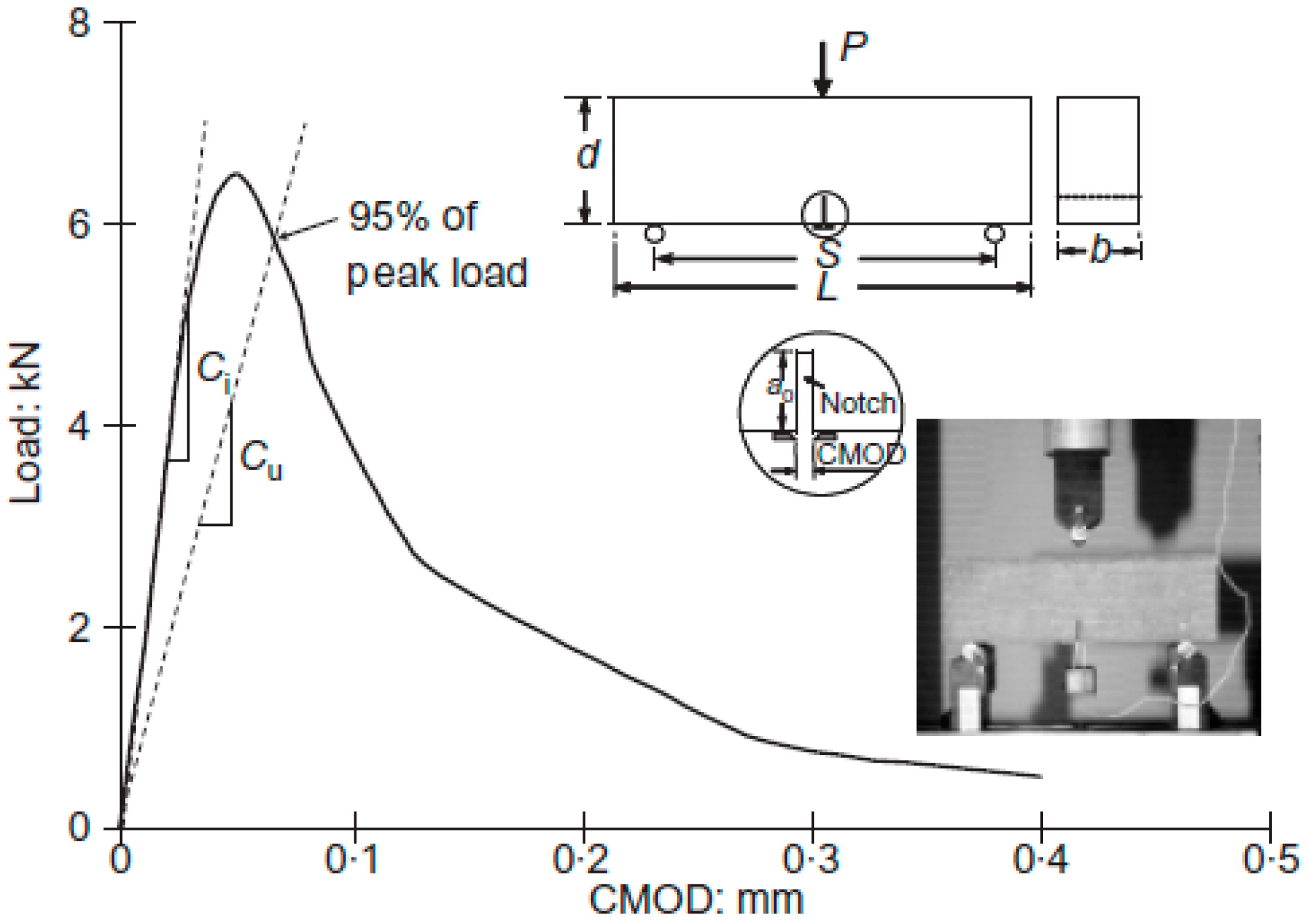
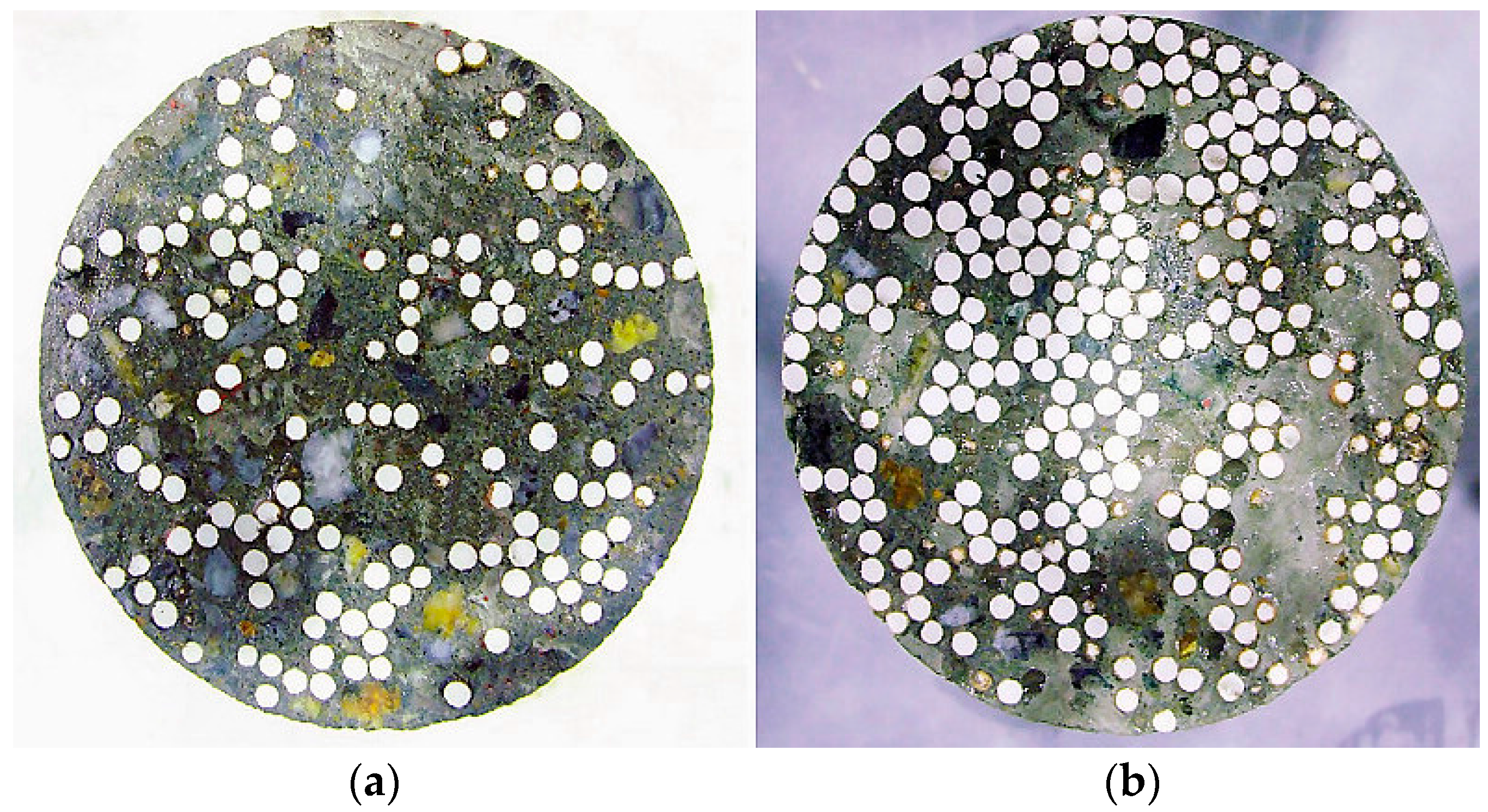

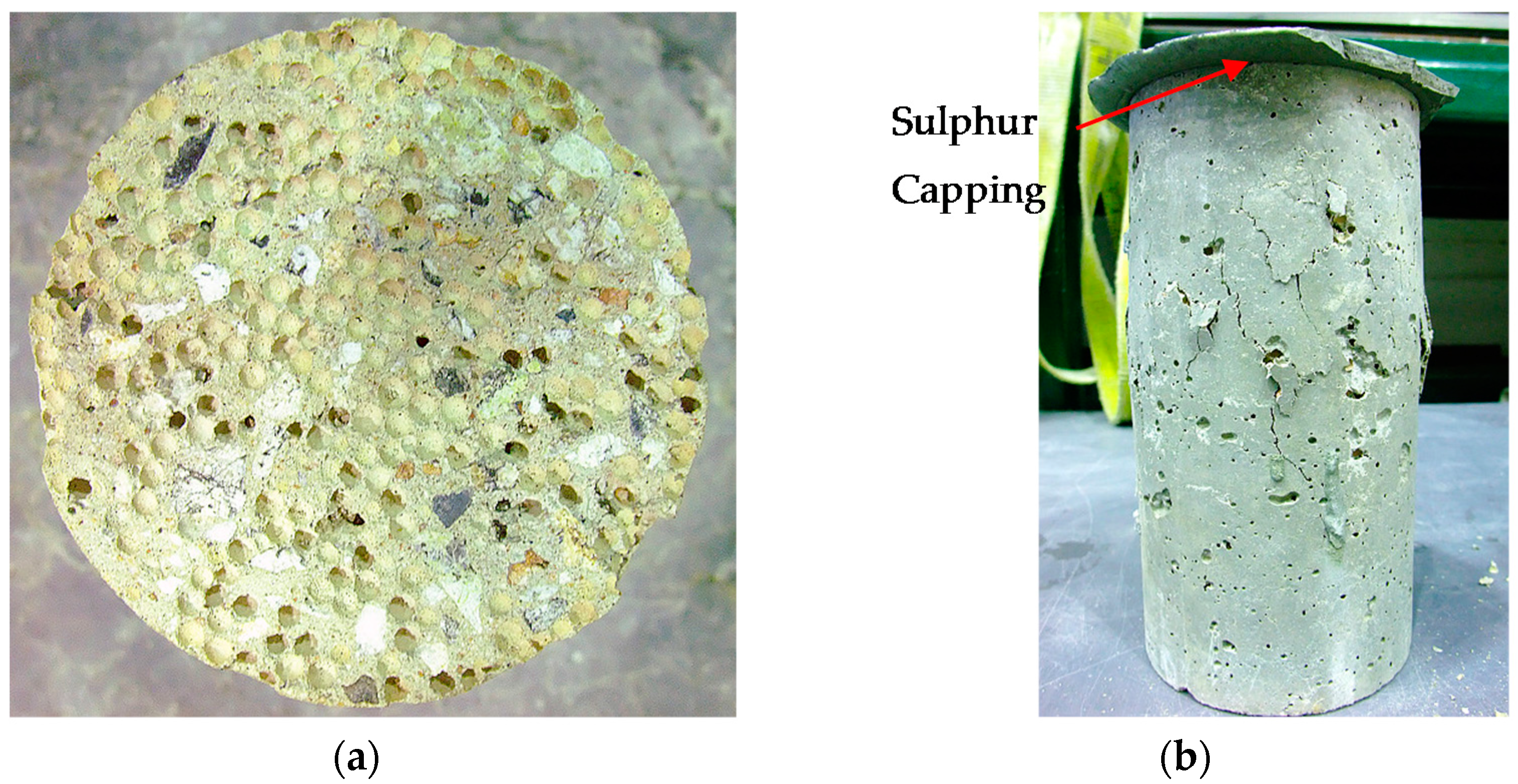
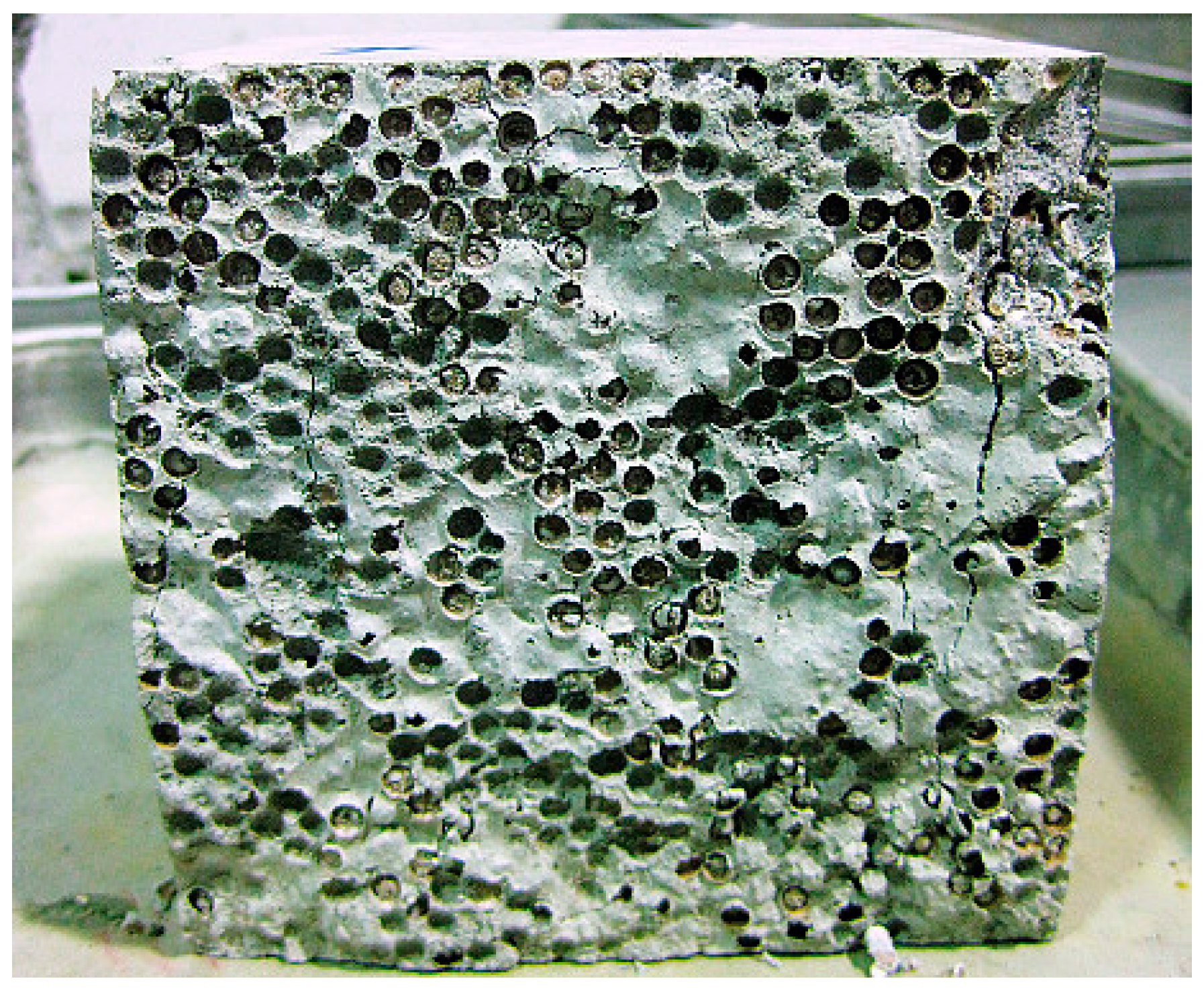
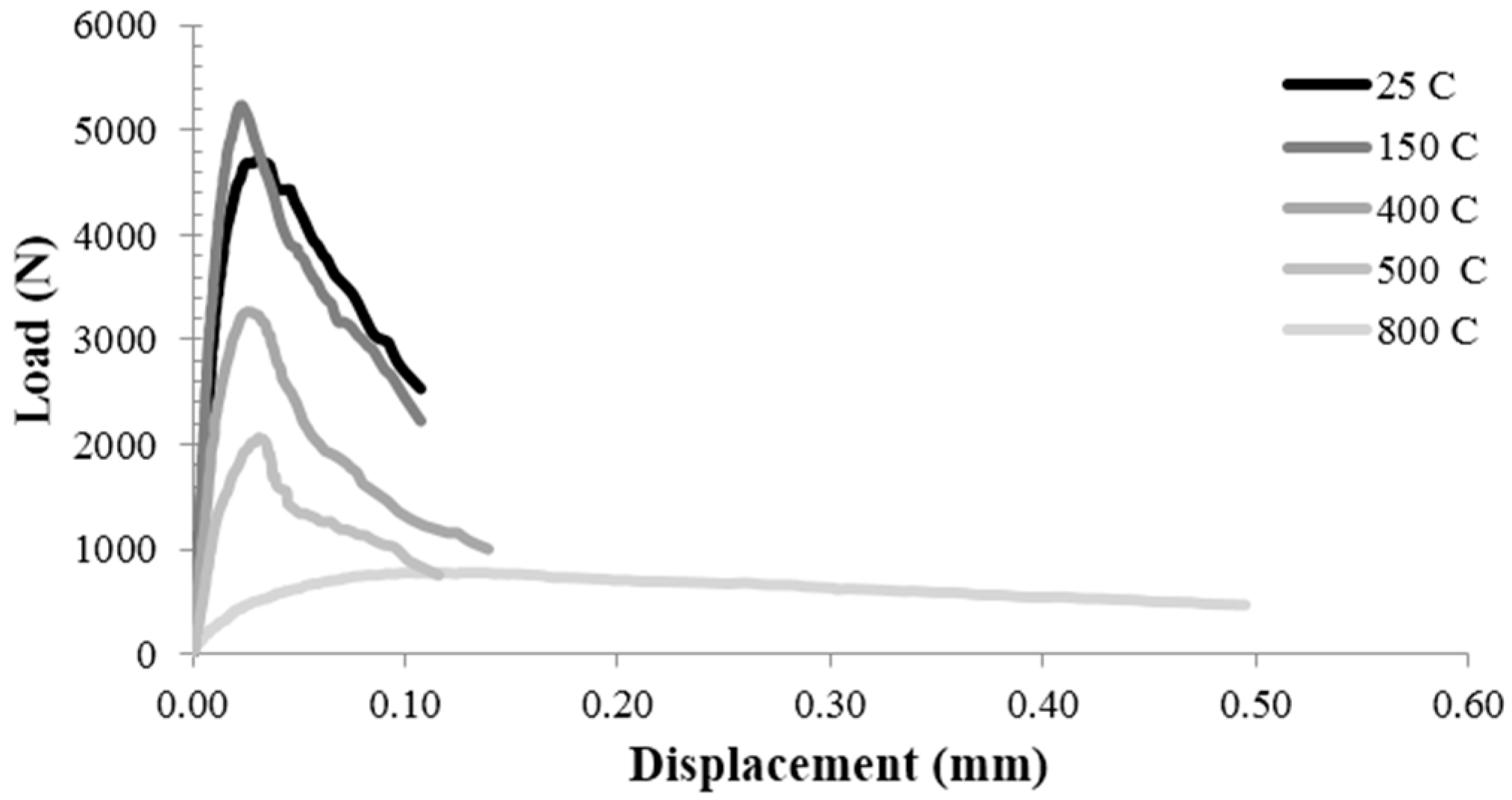
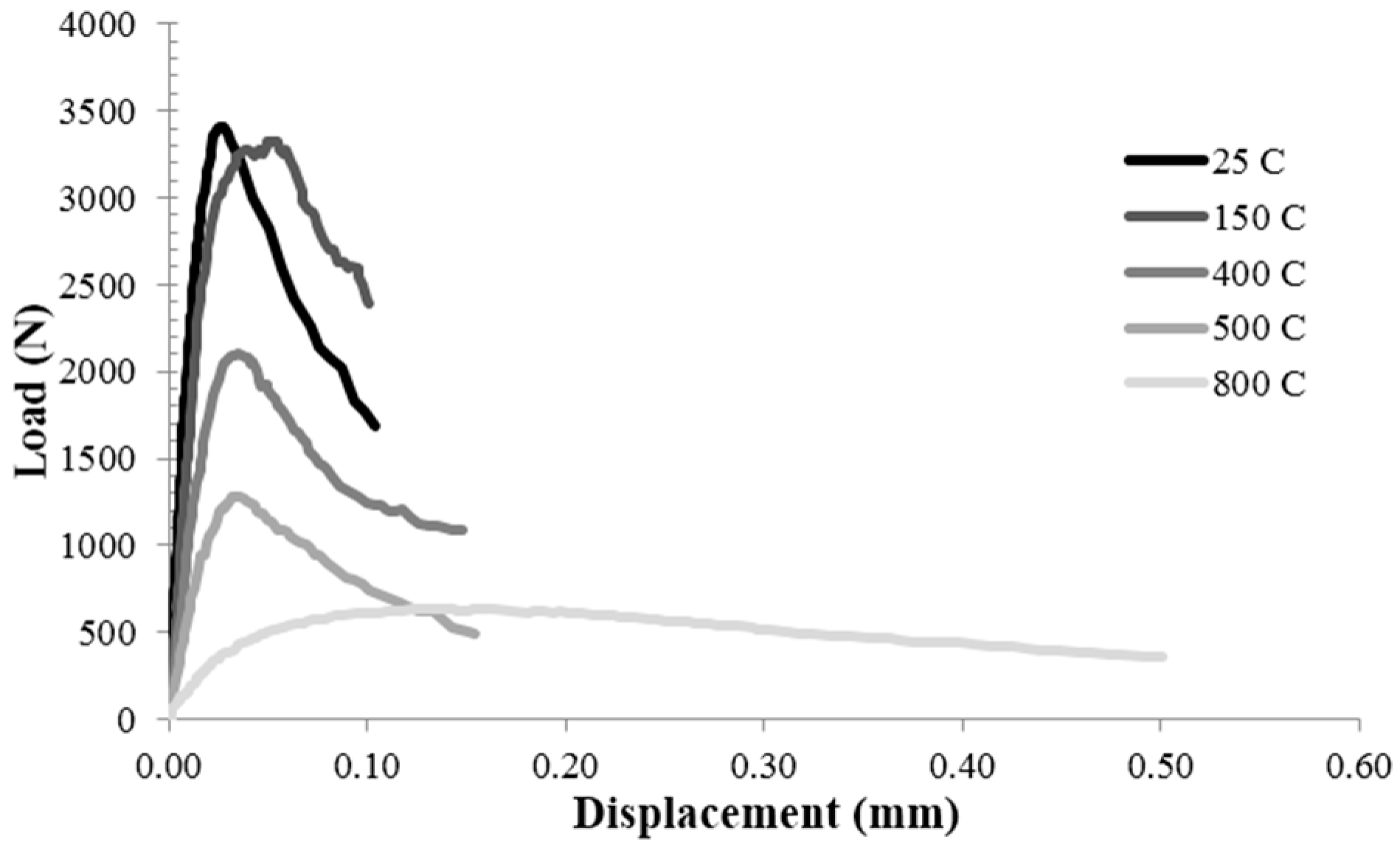
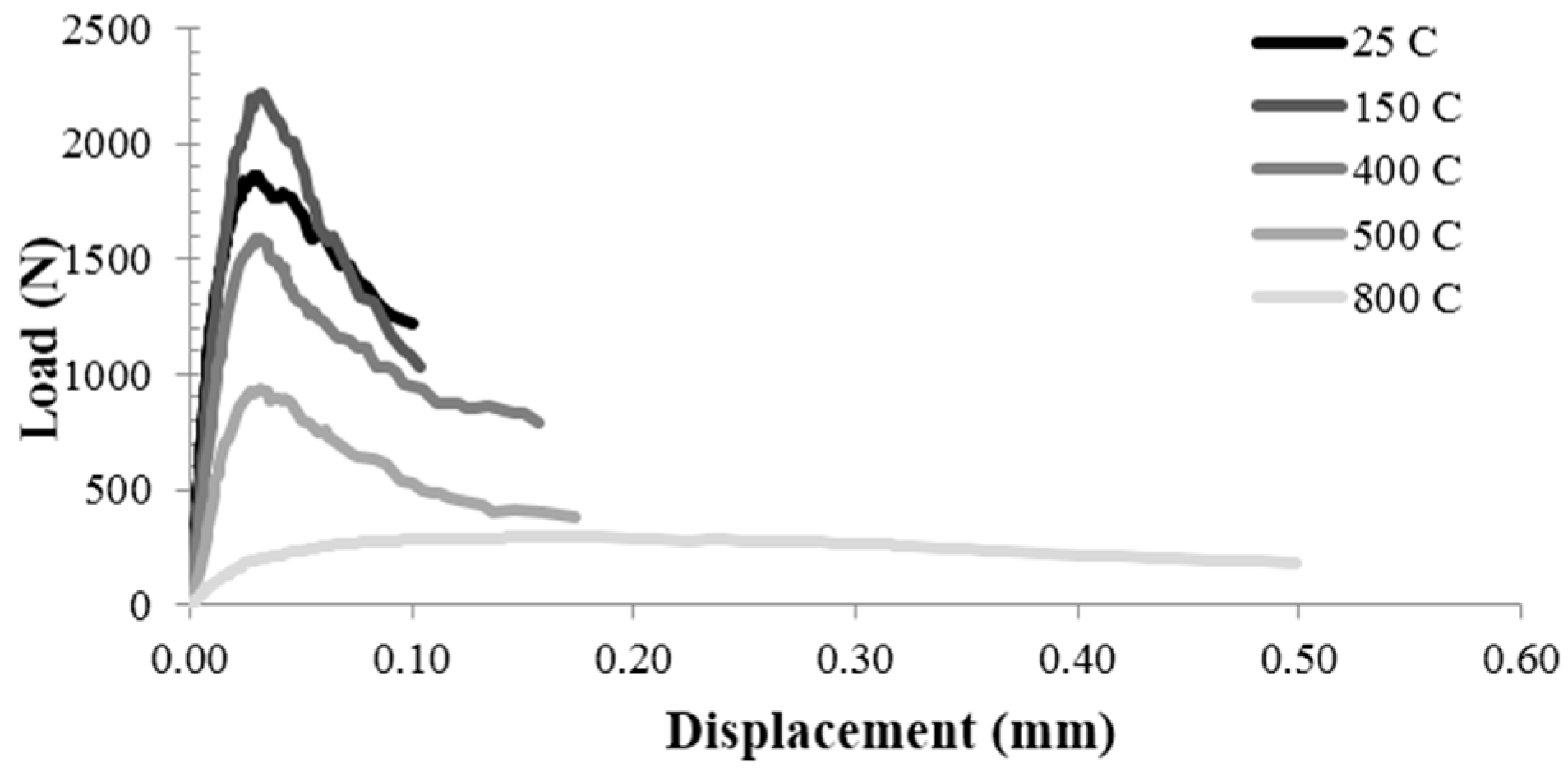
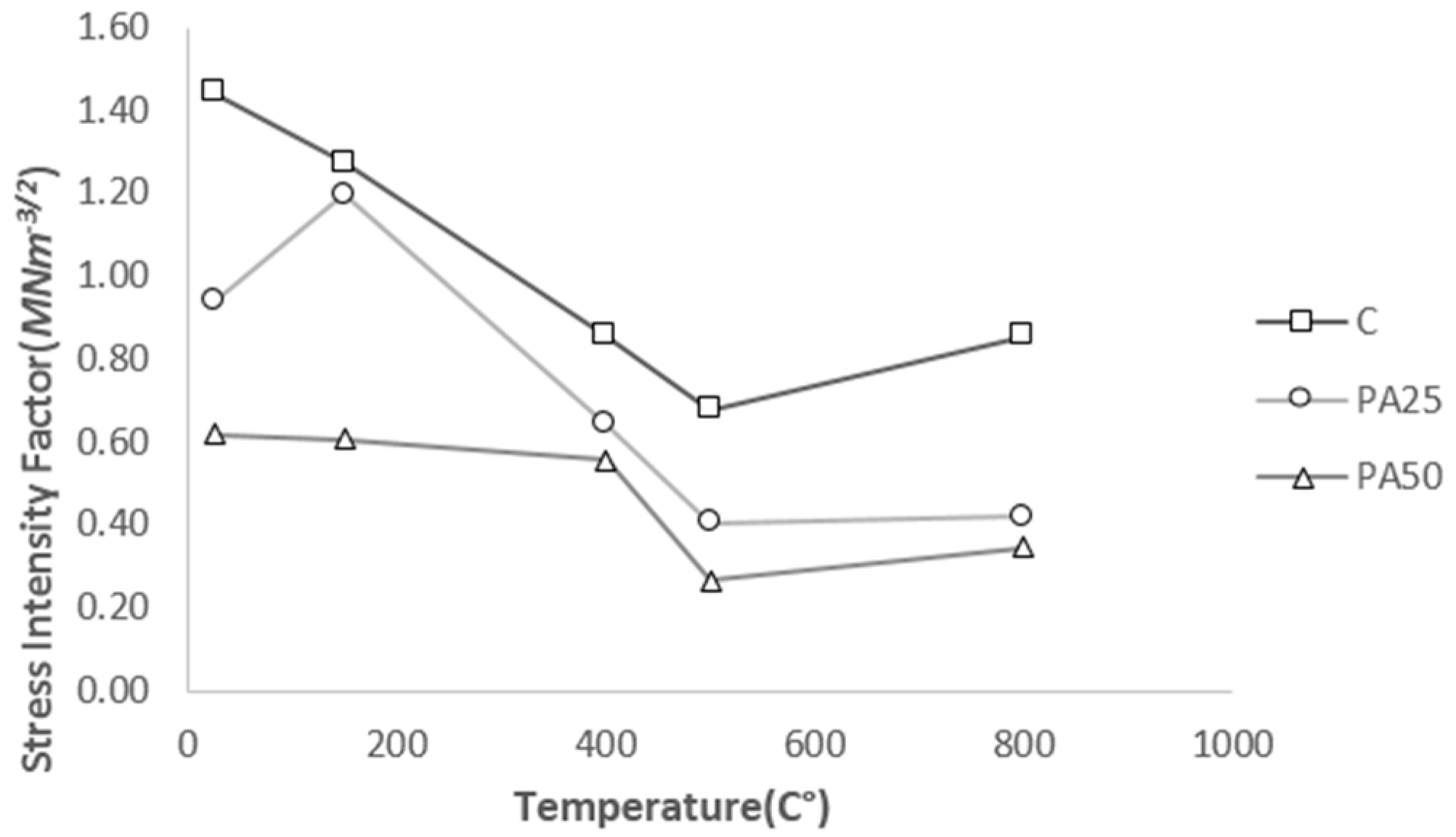
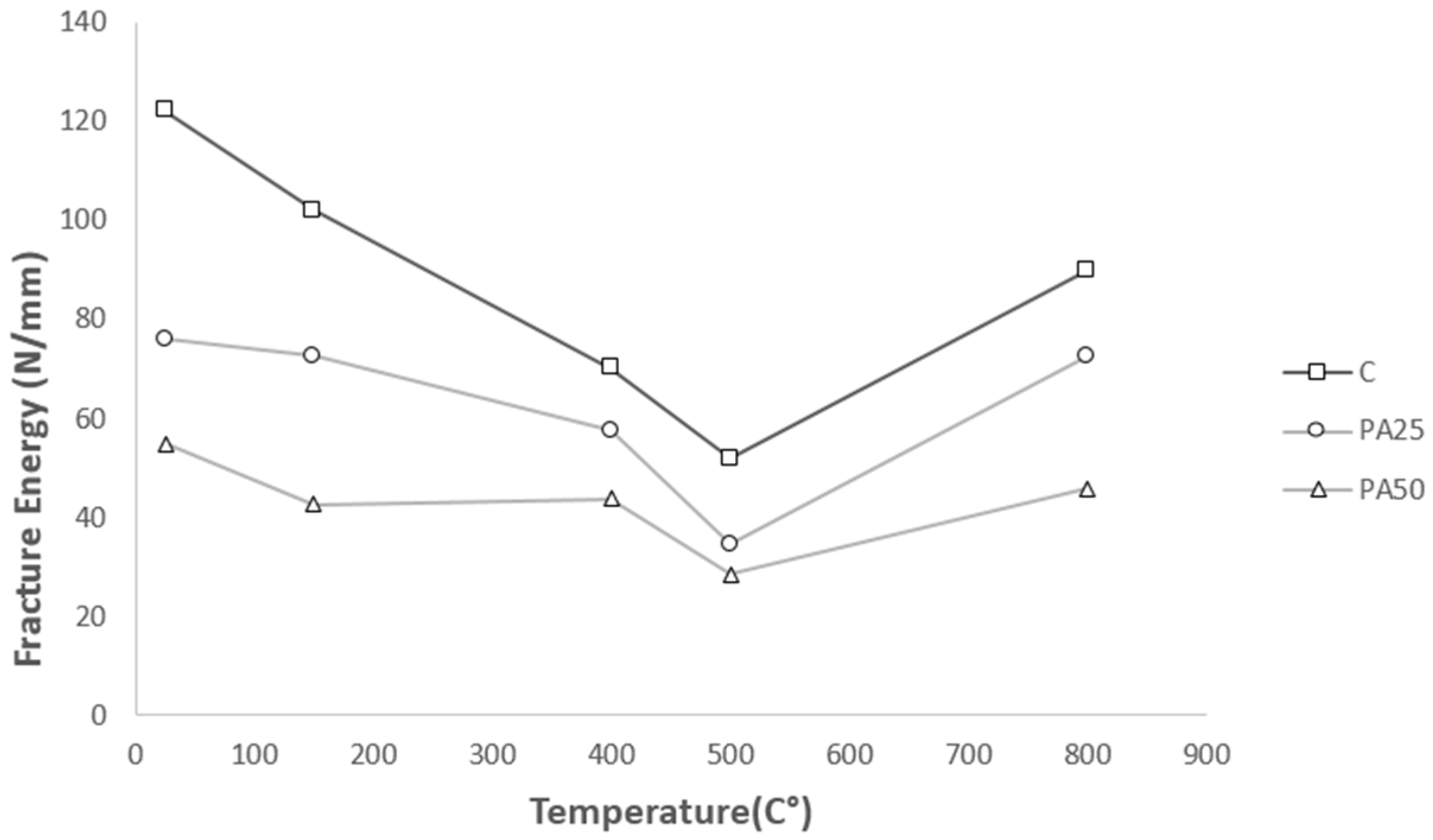
| Mix Code | Cement (kg/m3) | 10 mm Aggregate (kg/m3) | Sand (kg/m3) | Water (kg/m3) | Bulk Volume of PA in Liters (V) | Absolute Vol. Fraction of PA in Mix (%) * | Weight of PA Used (kg) |
|---|---|---|---|---|---|---|---|
| NC | 390 | 1130 | 610 | 195 | - | - | - |
| PA25 | 390 | 850 | 610 | 195 | 190 | 12.1 | 4.56 |
| PA50 | 390 | 565 | 610 | 195 | 380 | 24.2 | 9.12 |
| CONCRETE MIX | Peak Temp | Density kg/m3 | Mechanical Properties | Fracture Properties | |||||||
|---|---|---|---|---|---|---|---|---|---|---|---|
| fc | ft | ft/fc | E | GF | |||||||
| N/mm2 | % | N/mm2 | % | KN/mm2 | % | N/m | % | ||||
| C | 25 °C | 2325 | 56.8 | 100.0 | 4.30 | 100.0 | 7.57 | 37.3 | 100.0 | 122.2 | 100.00 |
| 150 °C | 2325 | 57.7 | 101.6 | 4.90 | 114.0 | 8.49 | 36.7 | 98.4 | 102.1 | 83.53 | |
| 400 °C | 2325 | 45.2 | 79.6 | 3.35 | 77.9 | 7.41 | 21.7 | 58.2 | 70.1 | 57.38 | |
| 500 °C | 2325 | 34.3 | 60.4 | 2.50 | 58.1 | 7.29 | 17.7 | 47.5 | 51.9 | 42.48 | |
| 800 °C | 2325 | 25.4 | 44.7 | 1.30 | 30.2 | 5.12 | 7.46 | 20.0 | 90.0 | 73.65 | |
| PA25 | 25 °C | 2050 | 26.4 | 100.0 | 2.90 | 100.0 | 10.98 | 25.1 | 100.0 | 76.0 | 100.00 |
| 150 °C | 2050 | 30.1 | 114.0 | 2.80 | 96.6 | 9.30 | 20.4 | 81.3 | 72.6 | 95.52 | |
| 400 °C | 2050 | 20.4 | 77.3 | 1.90 | 65.5 | 9.31 | 14.2 | 56.6 | 57.5 | 75.66 | |
| 500 °C | 2050 | 15.2 | 57.6 | 1.35 | 46.6 | 8.88 | 8.9 | 35.5 | 34.5 | 45.32 | |
| 800 °C | 2050 | 9.9 | 37.5 | 0.70 | 24.1 | 7.07 | 5.02 | 20.0 | 72.6 | 95.46 | |
| PA50 | 25 °C | 1770 | 13.3 | 100.0 | 1.50 | 100.0 | 11.28 | 17.4 | 100.0 | 54.9 | 100.00 |
| 150 °C | 1770 | 14.8 | 111.3 | 1.40 | 93.3 | 9.46 | 13.5 | 77.6 | 42.6 | 77.51 | |
| 400 °C | 1770 | 9.2 | 69.2 | 0.95 | 63.3 | 10.33 | 8.8 | 50.6 | 43.8 | 79.66 | |
| 500 °C | 1770 | 6.9 | 51.9 | 0.75 | 50.0 | 10.87 | 6.1 | 35.1 | 28.5 | 51.92 | |
| 800 °C | 1770 | 3.7 | 27.8 | 0.50 | 33.3 | 13.51 | 3.48 | 20.0 | 45.8 | 83.33 | |
| Mix Code | Temp °C | (MNm−3/2) | CTODC (mm), 10−3 | (Nm/m2) | Q (m), 10−2 | (Nm/m2) | (m) | |
|---|---|---|---|---|---|---|---|---|
| 25 | 0.46 | 1.44 | 8.00 | 55.8 | 4.40 | 122.2 | 0.246 | |
| 150 | 0.378 | 1.27 | 6.00 | 44.2 | 3.00 | 102.1 | 0.156 | |
| C | 400 | 0.405 | 0.86 | 7.00 | 33.7 | 3.50 | 70.1 | 0.136 |
| 500 | 0.48 | 0.68 | 8.00 | 26.0 | 4.60 | 51.9 | 0.147 | |
| 800 | 0.762 | 0.85 | 23.00 | 65.0 | 3.90 | 90.0 | 0.397 | |
| 25 | 0.423 | 0.94 | 7.00 | 35.2 | 3.80 | 76.0 | 0.227 | |
| 150 | 0.512 | 1.20 | 13.00 | 70.3 | 4.90 | 72.6 | 0.189 | |
| PA25 | 400 | 0.458 | 0.64 | 9.00 | 29.1 | 4.30 | 57.5 | 0.226 |
| 500 | 0.468 | 0.41 | 10.00 | 18.5 | 4.40 | 34.5 | 0.168 | |
| 800 | 0.668 | 0.42 | 18.00 | 53.0 | 4.90 | 72.6 | 0.743 | |
| 25 | 0.486 | 0.62 | 8.00 | 22.1 | 4.60 | 54.9 | 0.425 | |
| 150 | 0.419 | 0.61 | 9.00 | 27.2 | 3.80 | 42.6 | 0.293 | |
| PA50 | 400 | 0.501 | 0.56 | 14.00 | 35.1 | 4.80 | 43.8 | 0.427 |
| 500 | 0.433 | 0.27 | 9.00 | 11.7 | 3.90 | 28.5 | 0.309 | |
| 800 | 0.771 | 0.35 | 19.00 | 34.1 | 3.60 | 45.8 | 0.637 |
© 2016 by the authors; licensee MDPI, Basel, Switzerland. This article is an open access article distributed under the terms and conditions of the Creative Commons Attribution (CC-BY) license (http://creativecommons.org/licenses/by/4.0/).
Share and Cite
Tang, W.; Cui, H.; Tahmasbi, S. Fracture Properties of Polystyrene Aggregate Concrete after Exposure to High Temperatures. Materials 2016, 9, 630. https://doi.org/10.3390/ma9080630
Tang W, Cui H, Tahmasbi S. Fracture Properties of Polystyrene Aggregate Concrete after Exposure to High Temperatures. Materials. 2016; 9(8):630. https://doi.org/10.3390/ma9080630
Chicago/Turabian StyleTang, Waiching, Hongzhi Cui, and Soheil Tahmasbi. 2016. "Fracture Properties of Polystyrene Aggregate Concrete after Exposure to High Temperatures" Materials 9, no. 8: 630. https://doi.org/10.3390/ma9080630
APA StyleTang, W., Cui, H., & Tahmasbi, S. (2016). Fracture Properties of Polystyrene Aggregate Concrete after Exposure to High Temperatures. Materials, 9(8), 630. https://doi.org/10.3390/ma9080630








